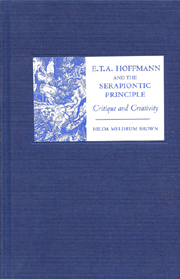Conclusion
Published online by Cambridge University Press: 05 February 2013
Summary
The above investigation of Hoffmann's ideas on aesthetics and their application to his own works has suggested a rather different image of the writer from that to which we are accustomed. We have been able first to identify a persistent undercurrent of reference to the fundamental issues that were being discussed by thinkers of the day, especially the relationship between “Geist” and “Natur.” Far from mere name-dropping — which has hitherto mostly served as an explanation for this phenomenon — Hoffmann consistently annexes this intellectual framework, which hinges for him on the centrality of the faculty of imagination, to his more practical concerns and applications of the creative process and its reception. The Serapiontic Principle is the chief unifying factor that brings together the more abstract and theoretical and the genial and inspirational aspects in this process. As we have seen, it is itself a multifaceted notion composed of various strands and developed continuously over the entire breadth of Hoffmann's career as a prose writer from the Fantasiestücke to Des Vetters Eckfenster, and it reaches a point of particular intensification, clarity, and elucidation in Die Serapionsbrüder. As a point of intersection between the general and the particular the principle serves, as I have demonstrated, to draw together the many and various insights that have for too long made Hoffmann's efforts at theorizing appear to be haphazard.
Hoffmann's constant, almost obsessive revisiting of the themes of imagination and creativity links him with the English Romantics such as Wordsworth and Coleridge.
- Type
- Chapter
- Information
- E. T. A. Hoffmann and the Serapiontic PrincipleCritique and Creativity, pp. 197 - 200Publisher: Boydell & BrewerPrint publication year: 2006

